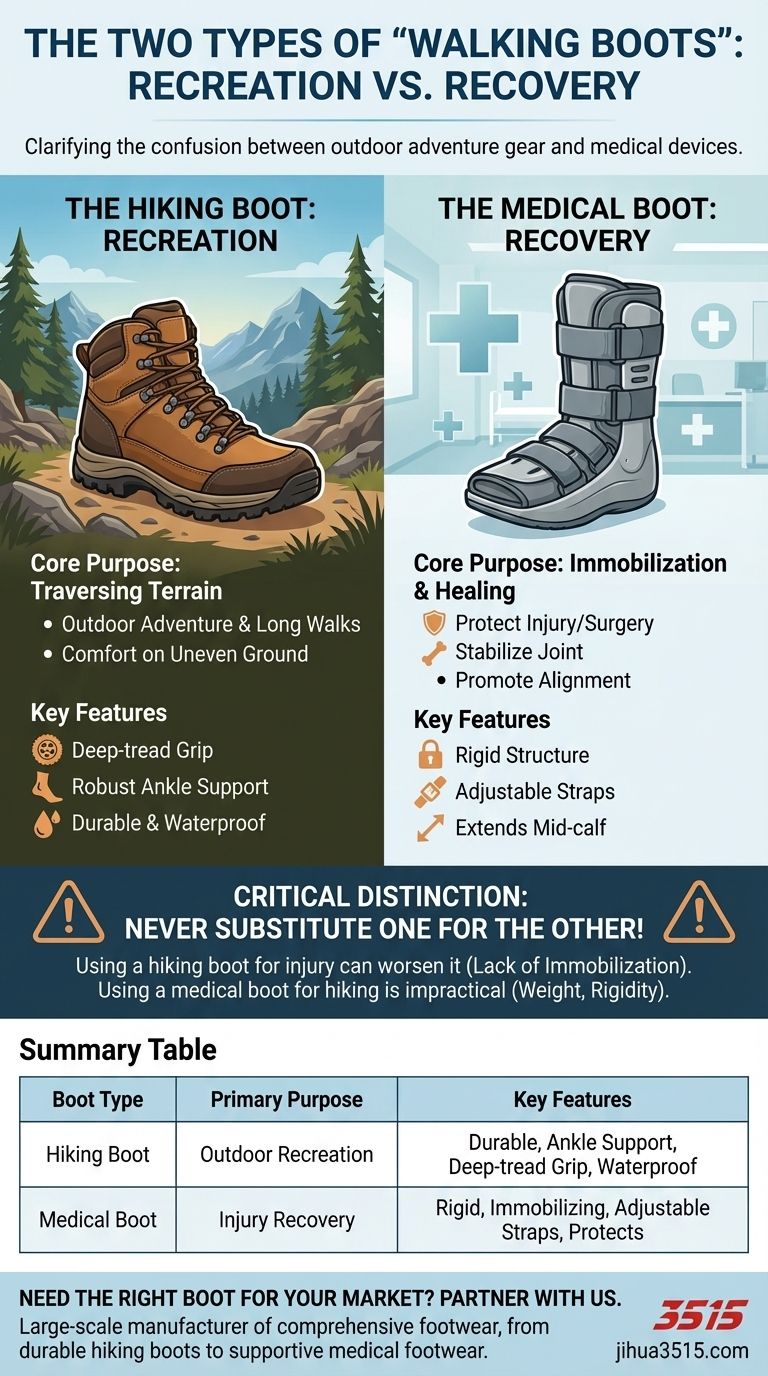A "walking boot" is a term for two fundamentally different types of footwear. It can refer to a hiking boot designed for outdoor recreation or, more commonly in a medical context, an orthopedic boot used to immobilize and protect an injured foot or ankle during recovery.
The core confusion arises because the term "walking boot" is used for both outdoor adventure gear and medical recovery devices. The key is to understand their distinct purposes: one is for recreation on trails, while the other is for recovery from injury.

The Hiking Boot: For Outdoor Adventure
A hiking boot, often called a walking boot in a recreational context, is specialized footwear engineered for outdoor activity.
Core Purpose: Traversing Terrain
The primary goal of a hiking boot is to provide comfort, support, and safety during long walks on uneven or challenging ground, such as trails and mountainsides.
Key Features: Grip and Support
These boots are built with durable materials, deep-treaded outsoles for excellent grip, and a structure that provides robust ankle support to prevent twists and sprains on rough surfaces. Many are also waterproof to handle varied weather conditions.
The Medical Boot: For Injury Recovery
A medical walking boot, also known as an orthopedic boot, is a device prescribed by a doctor to aid in healing.
Core Purpose: Immobilization and Healing
Its sole function is to protect the foot and ankle after an injury or surgery. It stabilizes the injured area, promotes proper alignment for healing, and reduces the weight-bearing forces that could cause further damage.
Key Features: Protection and Stability
Medical boots typically extend mid-way up the calf and feature adjustable straps to ensure a secure fit. Their rigid structure immobilizes the joint, allowing bones, tendons, or ligaments to heal correctly.
Common Medical Uses
These boots are used for a range of conditions, including bone fractures, severe sprains, tendon injuries, shin splints, or recovery following foot or ankle surgery.
The Critical Distinction: Recreation vs. Recovery
Understanding the difference between these two "walking boots" is essential to avoid misuse that could be ineffective or even dangerous.
The Source of Confusion
The term "walking boot" is ambiguous. While both boots allow you to walk, their intended function is entirely different. One enables challenging movement, while the other restricts it to allow for healing.
Never Substitute One for the Other
Using a hiking boot when you need a medical boot can worsen an injury by failing to provide the necessary immobilization. Conversely, attempting to hike in a medical boot is impractical and could lead to other issues due to its weight, rigidity, and lack of flexibility. The correct choice depends entirely on your goal.
Making the Right Choice for Your Goal
- If your primary focus is outdoor recreation: You need a hiking boot designed for grip, ankle support, and comfort on trails.
- If your primary focus is recovering from a foot or ankle injury: You need a medical boot prescribed by a healthcare professional to ensure proper and safe healing.
Ultimately, identifying your specific need—adventure or recovery—is the only way to select the correct boot.
Summary Table:
| Boot Type | Primary Purpose | Key Features |
|---|---|---|
| Hiking Boot | Outdoor recreation on trails | Durable, ankle support, deep-tread grip, waterproof |
| Medical Boot | Injury recovery and healing | Rigid, immobilizing, adjustable straps, protects foot/ankle |
Need the Right Boot for Your Needs? Partner with 3515.
As a large-scale manufacturer, 3515 produces a comprehensive range of footwear for distributors, brand owners, and bulk clients. Our production capabilities encompass all types of shoes and boots, from durable hiking boots for the outdoors to supportive medical footwear for recovery.
We can help you source or develop the perfect walking boot for your market. Contact us today to discuss your requirements and benefit from our manufacturing expertise.
Visual Guide

Related Products
- Safety Footwear Wholesale Manufacturer for Custom OEM/ODM Production
- Wholesale Leather Safety Boots with Customizable Protective Toe
- Customizable Anti-Smash Safety Boots for Wholesale & Private Label Manufacturing
- Wholesale Safety Footwear Manufacturer for Bulk & Custom OEM Orders
- Premium Grain Leather Safety Boots for Bulk Supply
People Also Ask
- What cultural and environmental considerations are tied to wearing shoes indoors? Balance Hygiene, Tradition, and Foot Health
- Is safety-toe as good as steel toe? Choose the Right Protection for Your Job
- What are OSHA approved shoes? Understanding the Correct Standards for Workplace Safety
- What are the differences between steel toe, composite toe, and alloy toe Wellington boots? Choose the Right Safety Toe for Your Job
- Is it normal to wear shoes in the house? A Guide to Hygiene, Comfort & Culture



















